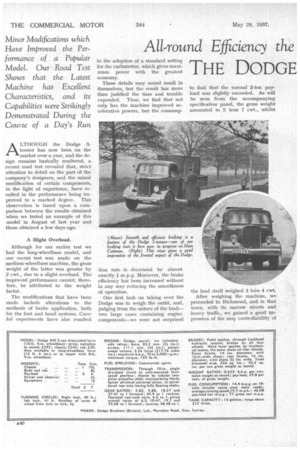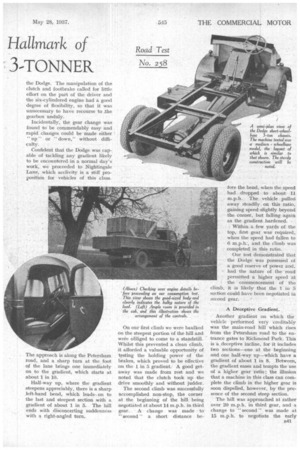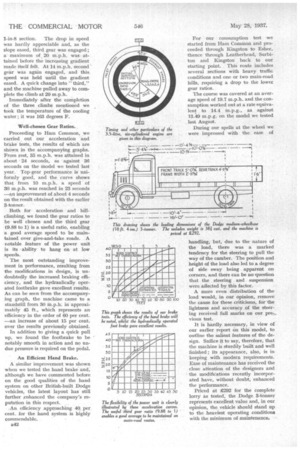All-round Efficiency the
Page 54

Page 55

Page 56

If you've noticed an error in this article please click here to report it so we can fix it.
Hallmark of
THE DODGE
3-TONNER
Road Test No. 258
Minor Modifications which Have Improved the Perforrnance of a Popular Model. Our -Road Test Shows that the Latest Machine has Excellent Characteristics, and its Capabilities were Strikingly Demonstrated During the Course of a Day's Run ALTHOUGH the Dodge 3tomer has now been on the market over a year, and the design remains basically unaltered, a, recent road test revealed that, strict attention to detail on the part of the company's designers, and the minor modification of certain components, in the light of experience, have resulted in the performance being improved to a marked degree. This observation is based upon a comparison between the results obtained when we tested an example of this model in August of last year and those obtained a few days ago.
A Slight Overload.
Although for our earlier test we had the long-wheelbase model, and our recent test was made on the medium-wheelbase machine, the gross weight of the latter was greater by 2 cwt., due to a slight overload. The improved performance cannot, therefore, be attributed to the weight factor, The modifications that have been made include alterations to the methods of brake application, both for the foot and hand systems. Careful experiments have also resulted
in the adoption of a standard setting for the carburetter, which gives maximum power with the greatest economy.
These details may sound small in themselves, but the result has more than justified the time and trouble expended. Thus, we find that not only has the machine improved accelerative powers, but the consump tion rate is decreased by almost exactly 1 m.p.g. Moreover, the brake efficiency has been increased without in any way reducing the smoothness of operation.
Our first task on taking over the Dodge was to weigh the outfit, and, judging from the nature of the load— two large capes containing engine components—we were not surprised to find that the normal 3-ton payload was slightly exceeded. As will be seen from the accompanying specification panel, the gross weight amounted to 5 tons 7 cwt., whilst
the load itself weighed 3 tons 4 cwt.
After weighing the machine, we proceeded to Richmond, and in that town, with its narrow streets and heavy traffic, we gained a good impression of the easy controllability of the Dodge. The manipulation of the clutch and footbrake called for little effort on the part of the driver and the six-cylindered engine had a good degree of flexibility, so that it was unnecessary to have recourse to ,the gearbox unduly.
Incidentally, the gear change was found to be commendably easy and rapid changes could be made either " up " or "down," without difficulty.
Confident that the Dodge was capable of tackling any gradient likely to be encountered in a normal day's work, we proceeded to Nightingale Lane, which acclivity is a stiff proposition for vehicles of this class.
The approach is along the Petersham road, and a sharp turn at the foot of the lane brings one immediately on to the gradient, which starts at about 1 in 10, Half-way up, where the gradient steepens appreciably, there is a sharp left-hand bend, which leads on to the last and steepest section with a gradient of about 1 in 5. The hill ends with disconcerting suddenness with a right-angled turn.
On our first climb we were baulked on the steepest portion of the hill and were obliged to come to a standstill. Whilst this prevented a clean climb, it afforded a valuable opportunity of testing the holding power of the brakes, which proved to be effective on the 1 in 5 gradient. A good getaway was made from rest and we noted that the clutch took up the drive smoothly and without judder.
The second climb was successfully accomplished non-stop, the corner at the beginning of the hill being negotiated at about 14 m.p.h. in third gear. A change was made to " second" a short distance be
fore the bend, when the speed had dropped to about 11 m.p.h. The vehicle pulled away steadily on this ratio, gaining speed slightly beyond the corner, but falling again as the gradient hardened.
. Within a few yards of the top, first gear was' required. when the speed had fallen to 6 m.p.h:, and. the climb was completed in this ratio.
Our test demonstrated that the Dodge was possessed of a good reserve of power and, had the nature of the "road permitted a higher speed at the commencement of the it is likely that the 1 in 5 could have been negotiated in gear. . • A Deceptive Gradient.
. Another gradient on Which the vehicle performed very creditably was the main-road hill which rises from the Petersham road to the entrance gates to Richmond Park. This is a deceptive incline, for it includes two sections—one at the beginning and one half-way up—which have a gradient of about 1 in 8. Between, the gradient eases and tempts the use of a higher gear ratio ; the illusion that a machine in this class can complete the climb in the higher gear is soon dispelled, however, by the presence of the second steep section.
The hill was approached at rather over 20 m.p.h. in third gear, and a change to " second " was made at 15 m.p.h. to negotiate the early 1-in-8 section. The drop in speed was hardly appreciable and, as the slope eased, third gear was engaged ; a maximum of 20 m.p.h. was attained before the increasing gradient made itself felt. At 14 m.p.h. second gear was again engaged, and thisspeed was held until the gradient eased. A quick change into "third," and the machine pulled away to complete the climb at 20 m.p.h.
Immediately after the completion of the three climbs mentioned we took the temperature of the cooling water ; it was 163 degrees F.
Well-chosen Gear Ratios. _ Proceeding to Ham Common, we carried out our acceleration and brake tests, the results of which are shown in the accompanying graphs. From rest, 35 m.p.h. was attained in about 24 seconds, as against 86 seconds on the model we tested last year. Top-gear performance is uniformly good, and the curve shows that from 10 m.p.h. a speed of 30 m.p.h. was reached in 23 seconds —an improvement of about 4 seconds on the result obtained with the earlier 3-tonner.
Both for acceleration and hillclimbing, we found the gear ratios to be well chosen and the third gear (9.88 to 1) is a useful ratio, enabling a good average speed to be maintained over give-and-take roads. A notable feature of the power unit is its • ability to hang on at low speeds.
The most outstanding improvement in performance, resulting from the modifications in design, is undoubtedly the increased braking efficiency, and the hydraulically operated footbrake gave excellent results. As can be seen from the accompanying graph, the machine came to a standstill from 30 m.p.h in approximately 45 ft., which represents an efficiency in the order of 60 per cent. —an increase of about 15 per cent. over the results previously obtained.
In addition to giving a quick pull up, we found the footbrake to be notably smooth in action and no undue pressure is required on the pedal.
An Efficient Hand Brake.
A similar improvement was shown when we tested the hand brake and; although we have commented before on the good qualities of the hand system on other British-built Dodge vehicles, the latest layout has still further enhanced the company's reputation in this respect.
An efficiency approaching 40 per cent. for the hand system is highly commendable. For our consumption test we started from Ham Common and proceeded through Kingston to Esher, thence through Leatherhead, Surbiton and Kingston back to our starting point. This route includes several sections with heavy traffic conditions and one or two main-road hills, requiring a drop to the lower gear ratios.
The course was covered at an average speed of 19.7 m.p.h. and the consumption worked out at a rate equivalent to 14.4 . m.p.g., as against 13.49 m.p.g. on the model we tested last August.
During our spells at the wheel we were impressed with the ease of handling, but, due to the nature of the load, there was a marked tendency for the steering to pull the way of the camber. The position and height of the load also led to a degree of side sway being apparent on corners, and there can be no question that the steering and suspension were affected by this factor.
A more even distribution of the load would, in our opinion, remove the cause for these criticisms, for the lightness and accuracy of the steering received full marks on our previous test.
It is hardly necessary, in view of our earlier report on this model, to
A.5 outline the salient features of the design. Suffice it to say, therefore, that the machine is sturdily built and well finished ; its appearance, also, is in keeping with modern requirements. Ease of maintenance has received the close attention of the designers and the modifications recently incorporated have, without doubt, enhanced the performance.
5 Priced at 2292 for the complete lorry as tested, the Dodge 3-tonner represents excellent value and, in our opinion, the vehicle should stand up to the heaviest operating conditions with the minimum of maintenance.
40 35 30 25 20 15 10
5
0
1131.% =MEM= MIER111111111 ME111111111=1 IPLIM
10 15 20 25 30 35 40 45 .30 5ECONDS
-•-
A.T113 GERA • CHRME.
II II
The flexibility
of the power unit is clearly illustrated by these acceleration curves. The useful third gear ratio (9.88 to I) enables a good average to be maintained on
main-road routes.




























































































